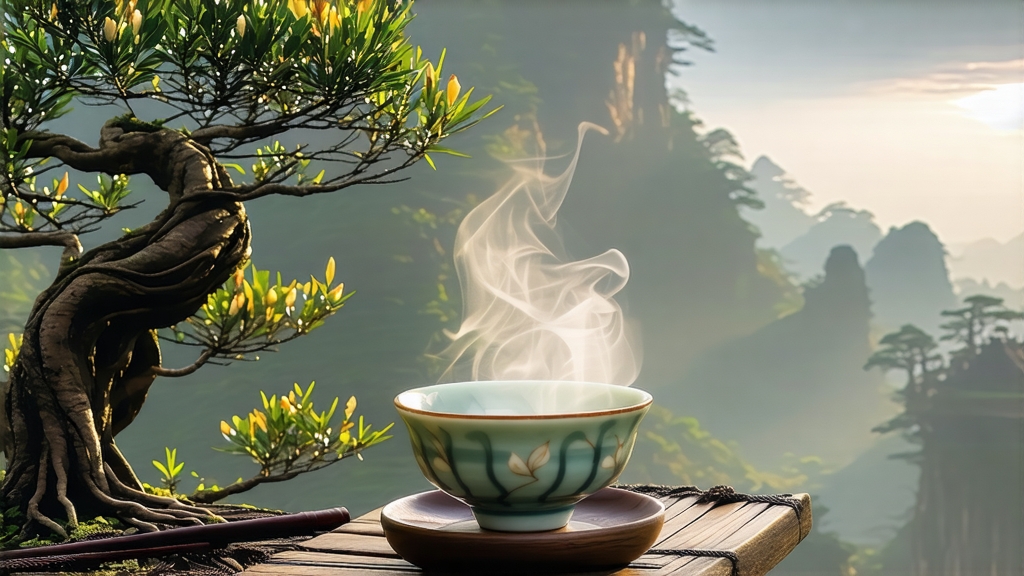
Tucked high in the mist-laden folds of Sichuan’s Meng Ding Mountain, where clouds brush the shoulders of 1,450-metre peaks, grows one of China’s most discreet aristocrats: Meng Ding Huang Ya, the “Yellow Bud from the Summit of Meng.” Unlike the celebrity greens of Hangzhou or the rock oolongs of Wuyi, this yellow tea has spent centuries in quiet anonymity, known mainly to emperors, Buddhist monks, and a handful of stubborn artisans who still speak the language of “sealed yellowing.” For the international drinker accustomed to the brisk snap of sencha or the honeyed malt of Assam, Meng Ding Huang Ya offers a different grammar of flavour—one that whispers instead of declares, and that teaches patience in both craft and cup.
Historical scrolls place the first tribute batch in the Tang dynasty (618-907 CE), when a local abbot presented “one hundred buds wrapped in lotus leaf” to the imperial courier station at Chengdu. By the Song, the tea had earned the moniker “Immortal Bud,” supposedly because a single bowl could keep a scholar alert through three nights of civil-service cramming. The Ming Yongle Emperor (r. 1402-1424) locked the mountain under state monopoly; any commoner caught picking without a jade tally faced exile to the Great Wall. Paradoxically, the same decree that elevated the tea nearly extinguished it: when the Qing collapsed in 1911, the monopoly fractured, demand vanished, and the secret of yellowing survived only in the muscle memory of three hereditary families. Not until 1959 did a state-sponsored expedition rediscover ancient shrubs hidden beneath feral azalea, allowing commercial revival on a minuscule scale—today fewer than 3,000 kg reach global markets each spring.
Meng Ding Huang Ya is not a generic “yellow tea”; it is a bud-only expression, plucked during the fifteen-day window when the mountain’s mean temperature hovers between 12 °C and 17 °C. Standard grade demands 70,000 buds per kilogram; the top “Imperial Sword” grade requires 120,000. Each bud must be unopened, no longer than 2.5 cm, and sheathed in down the colour of wheat chaff. Pluckers work barefoot so as not to bruise the plant, singing a four-note cadence that times the snip to the mountain’s heartbeat. By noon the wicker baskets descend to the village hall where the yellowing master, always the oldest artisan present, decides within seconds whether the day’s humidity justifies firing or wrapping—an intuition encoded in the local proverb: “The mountain breathes, the bud replies.”
The craft sequence follows five immutable steps: kill-green, wrapped yellowing, second firing, re-wrapped yellowing, and final gentle bake. The first wok is heated to 180 °C with wood from the fragrant nanmu tree; buds are tossed for exactly 90 seconds, just long enough to rupture peripheral enzymes while preserving the inner cell membrane. Immediately the semi-wilted buds are piled in linen sacks and slid into the “yellowing chamber,” a pine loft insulated with steamed rice straw. Here the magic of smothered oxidation occurs: over 48 hours the leaf temperature is allowed to creep back up to 38 °C, re-activating polyphenol oxidase in a low-oxygen environment. The result is a micro-fermentation that tints the leaf jade-gold and converts catechins into theaflavins, yielding the tea’s hallmark note of steamed corn milk. A second 70 °C firing halts the process, followed by another 24-hour wrapped rest, and finally a 50 °C bake until moisture drops to 5 %. Throughout, the artisan never leaves the loft; sleep is taken on a bamboo mat, nose tuned to the scent of loquat that signals danger—too much humidity and the buds will sour, too little and they remain green at the core.
Western tea science has only recently quantified what Meng Ding elders always knew: the dual yellowing reduces bitter EGCG by 28 % while doubling soluble sugars, creating a liquor that is sweet yet weightless, like dew condensed on river stone. Gas-chromatography reveals a rare lactone, 4-hydroxy-3-methylhexanoic-γ-lactone, responsible for the creamy finish that lingers 90 seconds on the retronasal epit